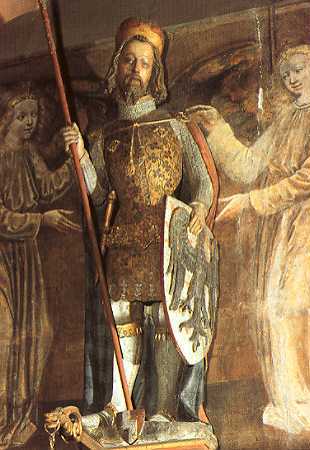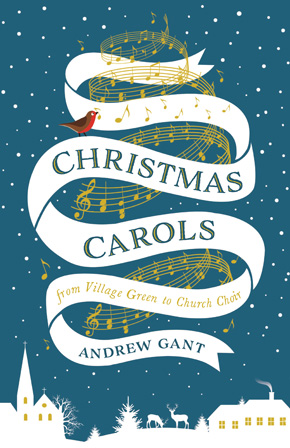Wenceslas squared
by Andrew GantEnglish Christmas carols are a hotchpotch, like the English themselves. Perhaps that’s why they are so popular. They have the power to summon up a special kind of midwinter mood, like the aroma of mince pies and mulled wine and the twinkle of lights on a tree. It’s a kind of magic.
How did they get that magic? Most of these songs were not composed as Christmas carols. Many were not ‘composed’ at all. Almost all did not begin life with the words they have now. Some didn’t have words at all. Several evolved from folk songs: some are evolving still. One much-loved carol started out as a song about a delinquent farm-boy and a couple of dead cows1. Many of the most ‘English’ carols have at least one ancestor in another country, in the mountains of Austria, or nineteenth-century America, or a Pyrenean hillside, in Lutheran psalters, handsome volumes of illuminated plainsong or sturdy hymnbooks from Finland, first opened by the flickering light of a fire in some stone hall one dark evening, deep in the sixteenth century.
Few carols have had so much scorn heaped on them as poor little ‘Good King Wenceslas’. Elizabeth Poston called it the “product of an unnatural marriage between Victorian whimsy and the thirteenth-century”, which is both ‘bizarre’ and ‘ridiculous’. Several writers have used the word ‘doggerel’. One went as far as calling it “ponderous moral doggerel”. The great Percy Dearmer expressed the pious hope that, “with the present wealth of carols for Christmas, ‘Good King Wenceslas’ may gradually pass into disuse.”
Good King Wenceslas wasn’t a king, and he wasn’t called Wenceslas. But he was good, so our mythologizing lyricist scores one out of three for historical accuracy.”
But it didn’t. The fact that Dearmer and Poston were wrong tells us something important about our carol tradition.
Good King Wenceslas wasn’t a king, and he wasn’t called Wenceslas. But he was good, so our mythologizing lyricist scores one out of three for historical accuracy, which is probably better than some. Our hero’s real name, in his native Czech, was Vaclav (‘Wenceslas’ seems to be a German version of the name), and he ruled as duke (not king) of Bohemia in the early tenth century. His family life was a trifle irregular. He was brought up by his grandmother until she was murdered by his mother, who then ruled as regent, but with such cruelty that she in turn was overthrown and exiled by Vaclav. He proved a wise and sympathetic monarch, deeply pious and dedicated to his beloved Catholic church, building many churches and shrines including St Vitus’s Cathedral, still standing within the walls of Prague castle. In 935 he was invited to dinner by his own brother, Boleslav, and was murdered. In a plot-twist worthy of ‘Macbeth’, Boleslav’s son was born on the very day of the murder.
There are lots of stories of Vaclav’s piety and good works. The tale of the page, the peasant and the pine-logs, of course, isn’t one of them. It’s fiction: one of those myths that gather around the image of a favourite saint or celebrity.
Almost a thousand years later a Victorian hymn writer and clergyman was looking for material for a new collection of carols. John Mason Neale was a prolific and popular writer. He has a whopping thirty-nine entries in the New English Hymnal, more than any other author, thirteen ahead of his nearest rival, Charles Wesley. Among his familiar efforts are ‘Jerusalem the Golden’, ‘All Glory, Laud and Honour’, ‘Christ is Made the Sure Foundation’, ‘Come, Ye Faithful, Raise the Anthem’, ‘The Day of Resurrection’, and many others. On this occasion he wanted a carol not for Christmas Day itself but for St Stephen’s Day, 26 December, one of the several feast days that fall during the liturgical ‘octave’, the eight days following a major festival of the church year.
The story of Stephen does not really lend itself to Christmas jollity, so Neale turned instead to the legend of Vaclav, which happens to be set on the right date. The link with Christmas is already looking a bit thin. True, St Stephen’s Day is chronologically, if not liturgically, closer to Christmas than some of the events we bundle up together and sing about at Christmas (Advent, Epiphany, the Annunciation). But the Feast of Stephen has nothing to do with Christmas, and anyway the carol is not about Stephen, it’s about Wenceslas, whose own feast day is in September. Any remaining tenuous link with the meaning of Christmas has been stretched almost beyond breaking-point.
This was one of the reasons why the brainy chaps of English music and letters took such a dislike to Neale’s carol. The other was his verse. Perhaps, at some level, they were nervous about his dangerously subversive message of social equality and redistribution of wealth. This was, after all, the age which readily got to its feet in church to heartily applaud the Almighty’s good sense in putting “the rich man in his castle, the poor man at his gate, God made them high and lowly, and ordered their estate”. Some found his moral tone hectoring and kitsch. Others just thought it was bad poetry. Some tried to untie his more tortured syntax. “Good my page” becomes, in some later editions, the rather more sensible “my good page”. But it didn’t stick. People didn’t like it.
Why? Because, whether we like it or not, a certain kind of sentimental, Victorian cod-mediaevalism rings the right bells. Or, as Neale might have put it, the right bells rings.

Statue of Saint Wenceslaus, probably by Peter Parler, 14th century, in St Vitus Cathedral, Prague. Wikimedia Commons
But on a more serious level, there is something challenging in Neale’s choice of subject-matter for his carol. Wenceslas is a saint of the Catholic church. The story Neale uses is not based on any documented incident in his life. It’s a myth. There are pictures of modern-day cardinals, red-hatted and resplendent, carrying Wenceslas’s 1,000-year-old skull on a gilded cushion in procession to the altar. This is the sort of thing which the men who founded Neale’s church in the sixteenth century absolutely loathed. Is there something slightly disturbing in the idea of an English cleric putting this sort of idolatry into the mouths of English choristers? His contemporaries thought so. Many were deeply distrustful of his brand of high-church Anglo-Catholicism. Once he was attacked at a nun’s funeral. Crowds threatened to stone him and burn down his house. His own bishop banned him from ministry for nineteen years.
For his tune, Neale turned to a book published in Finland in 1582. Piae Cantiones ecclesiasticae velerum episcoporum is a collection of school songs assembled by Jaako Suomalainen, headmaster of Turku cathedral school. In 1853 a British diplomat brought a copy home to London and gave it to Neale, who in turn shared it with his friend and fellow high-churchman Thomas Helmore, and forth they went together through the task of translating the texts, transcribing the musical notation and turning the results into suitably Victorianised choral arrangements, like some half-forged antique or bad bit of Gilbert Scott.
Few collaborations have produced such a concentration of repertoire items. Among their Christmas hymns are ‘O Come, O Come, Emmanuel’, ‘Of the Father’s Love Begotten’, ‘A Great and Mighty Wonder’, ‘Good Christian Men, Rejoice’ (‘In dulci jubilo’), ‘Unto Us is Born a Son’ (‘Puer nobis nascitur’), ‘Gabriel’s Message Does Away’ (‘Angelus emittitur’), ‘Christ was Born on Christmas Day’ (‘Resonet in laudibus’), ‘Let the Song be Begun’ (‘Personent hodie’), and many others. Within the manner of their age, Neale and Helmore were scholars, and brought much of the writing and music of the early and eastern churches back into the light of day. They virtually invented the modern use of plainsong.
Jaako Suomalainen, the singing headmaster in the sixteenth-century snows of Finland, used his song book as a vehicle for moral as well as musical instruction. This was a deeply Protestant notion, a flame still burning resolutely in the England of three centuries later. In 1854, Neale issued his carols in a ‘condensed’ version for children, and several other books aimed at young people. Others did the same. The carol we know as ‘Infant Holy, Infant Lowly’, for example, was imported from its native Poland by Edith M. Reed and published in Primary Education: A monthly journal for Primary Teachers, vol. XXVIII, no. 10, December 1920. Same idea: turn an exotic original into a polite English carol with a neat moral and a nice tune, though no doubt Neale’s Finnish lacked a certain polish.
Neale took the tune for ‘Good King Wenceslas’ unaltered from the Piae Cantiones. The tune probably pre-dates the book by about three hundred years. On this occasion, unlike his other gleanings from the Cantiones, Neale chose not to translate the original words. Easy to work out why. ‘Tempus adet floridum’ is a secular song about spring. Another version of this poem, from the Carmina Burana of the eleventh to the thirteenth centuries, goes into rather more detail about some of the activities traditionally associated with that time of year, principally among priests and virgins, apparently. Neale would have turned away a blushing eye.
It’s a great tune. Elizabeth Poston thinks it sounds better sung as intended, as an earthy spring song, stamping your feet and playing the hurdy-gurdy. She has a point. The quirky melisma in the last bar (‘fu-u-el’, etc.), which gives the last line the wrong number of beats, sounds as if it is inviting the singer to hurl his glass of schnapps skywards towards the roof-tree. But, not for the first time, an English clergyman decided to press a rambunctious old tune into the service of higher things.
‘Good King Wenceslas’ is a song. Just another winter’s tale. It may be only distantly related to Christmas, but it has the warm glow of a nice moral and a rousing tune, and it’s snowing. That’ll do. Our carols may not all turn out exactly as the grown-ups intended, but we can still love them for what they are.
1 The common tune for ‘O, Little Town of Bethlehem’ in the British Isles is ‘Forest Green’, adapted by Ralph Vaughan Williams from the English folk ballad ‘The Ploughboy’s Dream’.
This is an edited extract from Christmas Carols: From Village Green to Church Choir, an exploration of traditional carols and their unusual histories, published in hardback by Profile Books (£9.99)
 Andrew Gant is a composer, choirmaster, church musician, university teacher and writer. He has directed many leading choirs including The Guards’ Chapel, Worcester College Oxford, and Her Majesty’s Chapel Royal. He lectures in Music at St Peter’s College and St Edmund Hall in Oxford, where he lives with his wife and their three children. Christmas Carols is published by Profile Books in hardback and eBook. Read more.
Andrew Gant is a composer, choirmaster, church musician, university teacher and writer. He has directed many leading choirs including The Guards’ Chapel, Worcester College Oxford, and Her Majesty’s Chapel Royal. He lectures in Music at St Peter’s College and St Edmund Hall in Oxford, where he lives with his wife and their three children. Christmas Carols is published by Profile Books in hardback and eBook. Read more.
andrewgant.co.uk
Author portrait © Katie Vandyck


